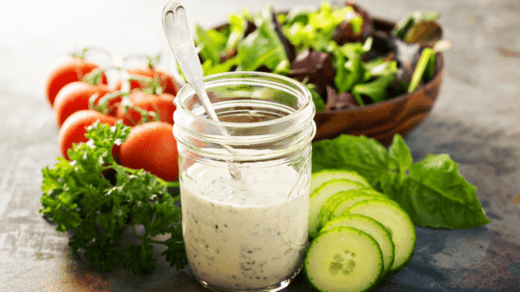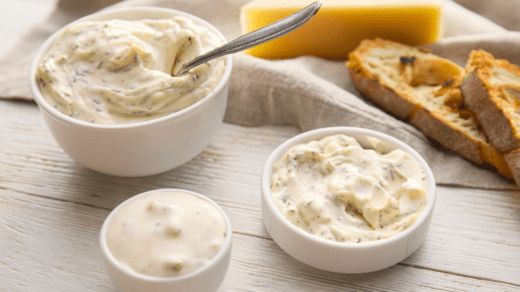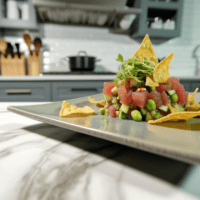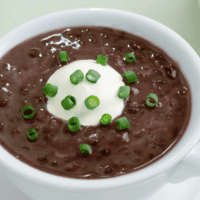Hey There! Some links on this page are affiliate links, which means that as an Amazon Associate, I may earn a small commission at no extra cost to you. I greatly appreciate your support! Learn more on my Affiliate Disclosure page.
Rough chopping is a fundamental kitchen skill that can save time and enhance cooking efficiency. Whether you’re making a hearty soup, a savory stew, or a fresh salad, knowing how to rough chop your vegetables can make all the difference.
Let’s dive into the basics of rough chopping carrots, onions, and celery, essential ingredients in many recipes. This guide will walk you through each step, ensuring you can chop like a pro in no time!
The Importance of Rough Chopping – VIDEO
Understanding why rough chopping is essential helps you appreciate the technique and its applications in various dishes. Rough chopping means cutting vegetables into large, irregular pieces.
Unlike finely diced vegetables, roughly chopped pieces add texture and depth to your dishes. This method is perfect for recipes where the vegetables cook for a long time, breaking down and melding into the dish, such as soups, stews, and braises.
Tools You Will Need

Before we start, gather your essential kitchen tools: a sharp chef’s knife, a sturdy cutting board, a vegetable peeler, a kitchen bowl, and kitchen towels. A sharp knife is crucial as it ensures clean cuts and minimizes the risk of accidents. A good cutting board provides a stable surface, and a vegetable peeler helps prepping your vegetables quickly and efficiently.
Step-by-Step Guide to Preparing and Rough Chopping Carrots

Step 1: Peel the Carrots
- Place the carrot on a cutting board.
- Use a vegetable peeler to remove the outer skin of the carrot.
Step 2: Trim the Carrot Ends
- Cut off both the top and bottom ends of the carrot to create a flat base, making it easier and safer to handle.
Step 3: Cut the Carrot in Half Lengthwise
- Hold the carrot firmly on the cutting board.
- Using a sharp chef’s knife, cut the carrot in half lengthwise.
Step 4: Further Cut if Necessary
- If the carrot is particularly thick, cut each half lengthwise again to create more manageable pieces.
Step 5: Slice the Carrot Crosswise
- Slice the carrot halves crosswise into uniform chunks, roughly the size of your thumb.
- Ensure the pieces are similar in size to guarantee even cooking.
Step-by-Step Guide to Preparing and Rough Chopping Onions
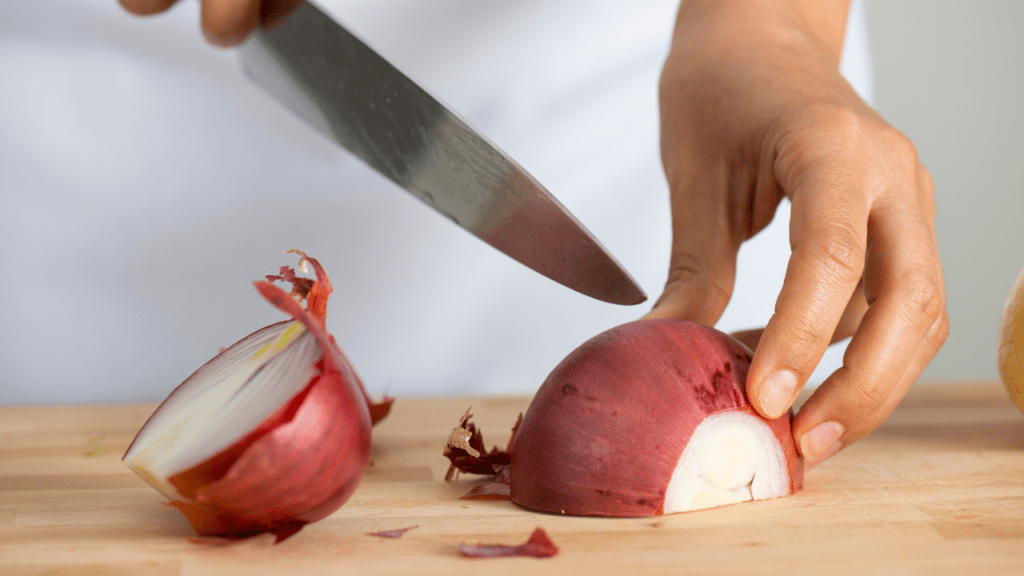
Peel and Halve the Onion
- Cut off the top of the onion.
- Peel away the papery skin.
- Cut the onion in half from top to bottom, through the root. This creates a flat surface, making the onion more stable and easier to chop.
Make Vertical Cuts
- Place the onion half flat-side down on the cutting board.
- Make several vertical cuts from the top of the onion to the root, but do not cut through the root. This keeps the onion layers together.
Make Horizontal Cuts
- Make horizontal cuts across the onion to create large chunks. The root end will hold the onion together, making the chopping process easier.
Step-by-Step Guide to Preparing and Rough Chopping Celery

Wash and Trim the Celery
- Wash the celery stalks thoroughly under running water to remove any dirt trapped in the crevices.
- Trim off the top leafy parts of the celery stalks.
- Trim off the base of the celery stalks.
Slice the Celery Crosswise
- Lay the celery stalks on your cutting board.
- Slice the celery stalks crosswise into chunks about an inch long. This size is perfect for soups and stews.
- Ensure the pieces are roughly the same size to guarantee even cooking.
Combining the Ingredients

Now that you have chopped carrots, onions, and celery, mix them as the base for many delicious recipes, from soups to stir-fries. This trio of vegetables, often called mirepoix in French cooking, forms the flavor foundation for countless dishes. By mastering the art of rough chopping these vegetables, you’re well on your way to becoming a more efficient and skilled home cook.
Tips and Tricks

Here are some additional tips to make your rough chopping more efficient and enjoyable:
- Keep Your Knife Sharp: A sharp knife is safer and more efficient than a dull one. To maintain its edge, regularly sharpen and hone your knife with steel.
- Use a Large Cutting Board: A spacious cutting board provides plenty of room for chopping and keeps your workspace organized.
- Practice Your Knife Skills: The more you practice, the more comfortable and faster you’ll become. Start slow and focus on your technique.
- Work in Batches: If you have a lot of vegetables to chop, work in batches to maintain control and ensure uniform pieces.
Conclusion

Mastering the art of rough chopping carrots, onions, and celery is a valuable skill that can significantly streamline your meal preparation and elevate your cooking. These foundational techniques not only save you time but also ensure that your dishes have a uniform texture and flavor.
Whether you’re a beginner or an experienced cook, practicing and perfecting your rough chopping will make your kitchen experience more enjoyable and efficient. So grab your knife, gather your veggies, and start chopping your way to delicious, homemade meals!
Thank you so much for investing your time in this article. If you’ve found it valuable (and we hope you have), why not stay connected with us? Join our mailing list to unlock a treasure trove of informative articles, exciting updates, and exclusive content.
Happy Cooking!
Frequently Asked Questions (FAQs)

1. What does “rough chop” mean?
- Rough chopping refers to cutting vegetables into large, irregular pieces. It’s less precise than dicing or mincing and is often used when the vegetables are cooked down in recipes like soups and stews.
2. Why is rough chopping important?
- Rough chopping is essential for creating uniform pieces that cook evenly. It also saves time compared to more precise chopping methods and is perfect for recipes where the vegetables will break down during cooking.
3. How do I keep my knife sharp?
- To keep your knife sharp, use honing steel regularly to maintain the edge and have your knives professionally sharpened, or use a sharpening stone every few months, depending on how often you cook.
4. Can I use a food processor to rough chop?
- While a food processor can chop vegetables quickly, it often results in uneven pieces and can over-process some vegetables. It’s best to chop by hand for more control and better texture.
5. What’s the difference between rough chopping and dicing?
- Rough chopping results in larger, irregular pieces, while dicing creates small, uniform cubes. Rough chopping is quicker and less precise, ideal for recipes where exact sizes aren’t crucial.
6. Do I need to peel carrots before rough chopping?
- Yes, peeling carrots before chopping removes the outer skin, which can be tough and bitter. It ensures a cleaner, more appealing final dish.
7. How do I prevent onions from making me cry while chopping?
- To reduce tears when chopping onions, chill the onions in the refrigerator for 30 minutes before chopping, and use a sharp knife to minimize cell damage and the release of tear-inducing compounds.
8. Can I store chopped vegetables for later use?
- Yes, you can store chopped vegetables in an airtight container in the refrigerator for up to 3 days. This can save you time during meal prep.
9. What dishes commonly use roughly chopped carrots, onions, and celery?
- Rough-chopped carrots, onions, and celery are often used in soups, stews, casseroles, and braises. They form the base of many recipes and add flavor and texture.
Hey There! Some links on this page are affiliate links, which means that as an Amazon Associate, I may earn a small commission at no extra cost to you. I greatly appreciate your support! Learn more on my Affiliate Disclosure page.











